POLTAVA. Краєзнавчий матеріал для читання чи аудіювання.

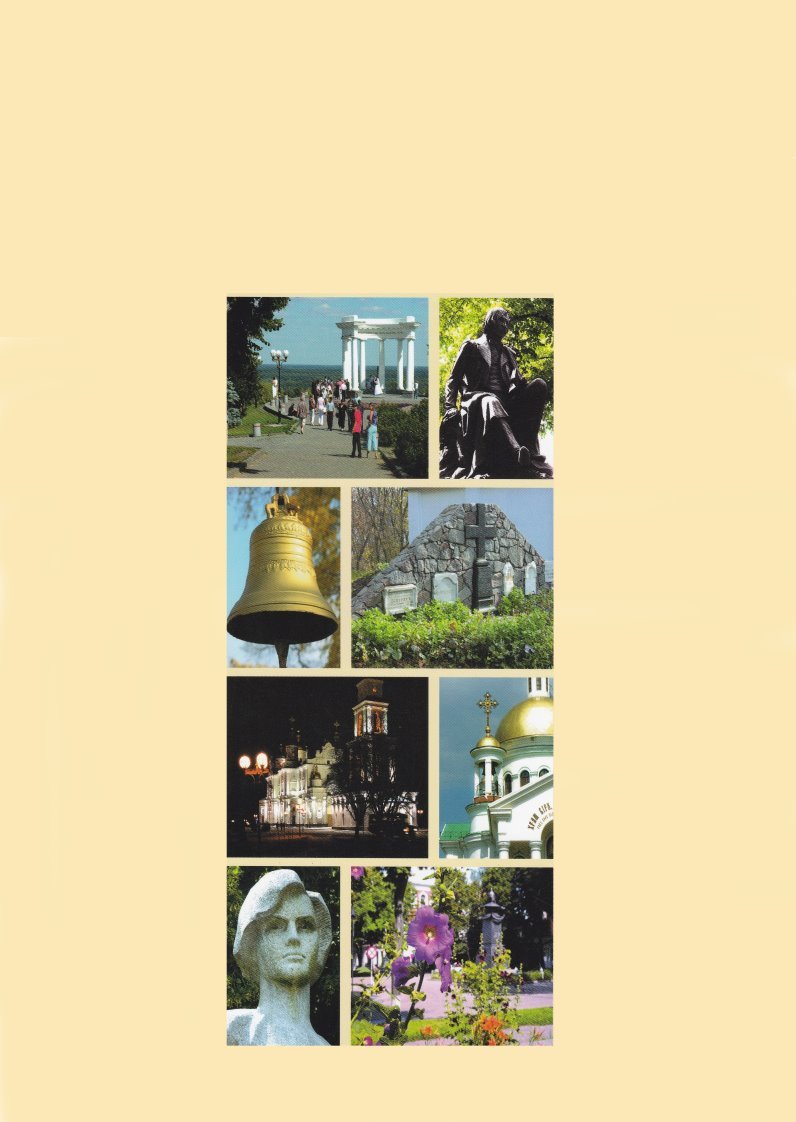
 Плоске 2019
Плоске 2019
Краєзнавчий матеріал по темі “ Пам’ятники Полтави”
Автор-упорядник Хриплива Т. О. – Плоске 2019 – 17 с.
Мета посібника - ознайомити учнів, гостей міста з культурними пам’ятками Полтави, поглибити їх знання про визначні місця міста.
До посібника увійшли тексти про музеї та пам’ятники Полтави, взяті з Інтернету, довідників, новітніх публікацій, а також розроблені євроклубівцями.
Посібник стане у нагоді вчителям та учням, які прагнуть збагатити словниковий запас, вдосконалити мовленнєві навички та туристам, які хочуть долучитися до культурної спадщини Полтави.
Плоске
Євроклуб “Dream Team”
![]()
 THE MONUMENT TO YURIY KONDRATIUK
THE MONUMENT TO YURIY KONDRATIUK
 Yuriy Kondratiuk (Alexander Shargey) belongs to the cohort of scientists who were first to have predicted space exploration. Enthusiasts, who were researching with this issue, were considered to be hopeless dreamers, and sometimes were simply laughed at. The same thing happened to Yuriy Kondratіuk.
Yuriy Kondratiuk (Alexander Shargey) belongs to the cohort of scientists who were first to have predicted space exploration. Enthusiasts, who were researching with this issue, were considered to be hopeless dreamers, and sometimes were simply laughed at. The same thing happened to Yuriy Kondratіuk.
Working hard over this problem and constantly improving his manuscripts, Kondratіuk has become generally recognized theorist of cosmonautics with his non-standard, original thinking. As a result, nowadays his name levels the names of such outstanding scientists as K. Tsyolkovskyi, F. Tsander, R. Hoddard, H. Obert.
Y. Kondratiuk museum of aircraft and cosmonautics was opened on the 23rd of September, 2001 in the memorial house that was built in 1810. Among the other museums of Poltava it stands out for its originality and unusual tendency.
In the exposition of the museum there are unique materials about scientists, engineers, aerospace constructors, pilots, cosmonauts whose lives and activities were connected with Poltava.
Among them are: O. M. Zasyadko, a scientist, artilleryman, constructor of the military equipment; O.M. Kovanko, a founder of military aerostatics etc.
Museum expositions are represented with more than 4000 exhibits and scientific archive that consists of 5000 items.

![]() HOUSE-MUSEUM OF PANAS MYRNYI
HOUSE-MUSEUM OF PANAS MYRNYI
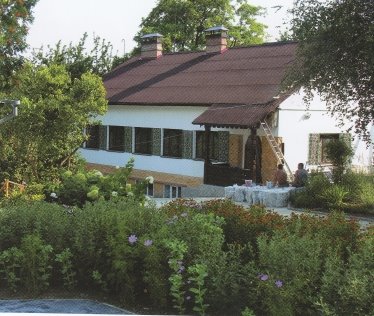 The writer’s museum is situated in the very end of the former third Kobyshyans’ka street (nowadays Panas Myrnyi street), in the house which Panas Myrnyi (P.Y. Rudchenko) bought in March, 1903 and where the writer spent the last 17 years of his life.
The writer’s museum is situated in the very end of the former third Kobyshyans’ka street (nowadays Panas Myrnyi street), in the house which Panas Myrnyi (P.Y. Rudchenko) bought in March, 1903 and where the writer spent the last 17 years of his life.
P. Myrnyi museum is one of the richest museums among the similar ones in Ukraine. There are app. 1000 items, books, documents and pictures there. All exhibits are preserved in seven rooms of the house. There are more then 150 manuscripts of Panas Myrnyi and his brother Ivan Bilyk, 280 pages of the epistolary heritage of the writer and his family, first editions of his works, contemporaries’ recollections etc.
The country estate has been the monument of the landscape architecture since 1976. There are centennial trees among which are two oaks which are app. 300 years old.

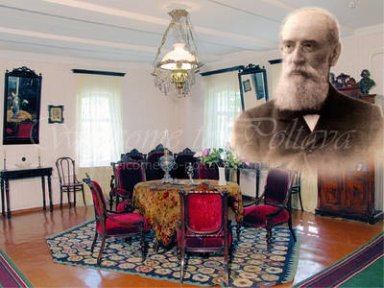
![]()
 THE MONUMENT TO DUMPLINGS
THE MONUMENT TO DUMPLINGS
In a quiet, snug and picturesque corner of the historic part of Poltava on Ivan's Hill alongside with the homonymous restaurant there is an unusual monument dedicated to that worldwide known Poltava dumpling made of wheat or buckwheat batter cooked in boiling water, which is one of symbols of the city.
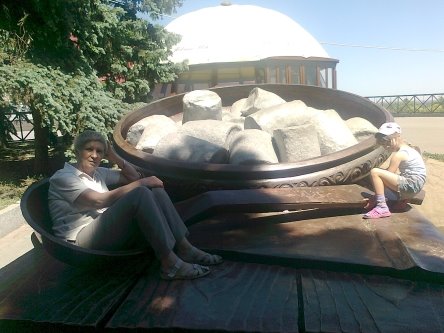 This artifact symbolizing abundance and prosperity of a family represents a huge bowl with 12 boiled dumplings and a huge cyclopean spoon as deep as a scoop on a pedestal in the form of a wooden desktop partially covered with a towel. This kind of Poltava distinction mark has been created by the People's Artist of Ukraine Anatoly Chernoshchokov and sculptor Mykola Tsys.
This artifact symbolizing abundance and prosperity of a family represents a huge bowl with 12 boiled dumplings and a huge cyclopean spoon as deep as a scoop on a pedestal in the form of a wooden desktop partially covered with a towel. This kind of Poltava distinction mark has been created by the People's Artist of Ukraine Anatoly Chernoshchokov and sculptor Mykola Tsys.
The stone monument memorializing the traditional Ukrainian folk dish has been inaugurated on April 1, 2006 and not dedicated to All Fools’ Day but to the anniversary of M. V. Gogol who made the Ukrainian dumplings famous in the world. The Poltava Halushka Festival is annually staged near the monument at the Sobornyi Maidan (Cathedral Square). Eeveryone can enjoy the dumplings with meat, curd, sour cream, liver, potatoes and cracklings, with different spices at and to watch Cooking Contest to cook the most delicious dumplings as well as concerts, competitions, theatrical show based on works by Ivan Kotliarevsky and Gogol, and the exhibition “History of Poltava dumplings”.
In May 2008, Hennady Chipko, a 19-year-old third-year student of Poltava University of Consumer Cooperatives, has set a Guinness World Record for speed eating the dumplings: he has eaten a portion of 12 dumplings for 52.3 seconds.
To tell the truth, it is easier to find today in Poltava a monument to this national dish, than dumplings in the menu of local restaurants.
![]()
 THE MONUMENT TO GOGOL
THE MONUMENT TO GOGOL
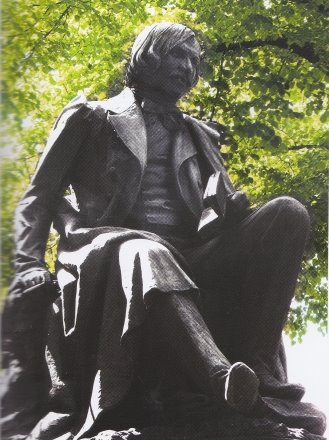 M. V. Gogol is an outstanding writer. The description of Poltava practically does not occur in Gogol’s works, but still the destiny of the great writer closely intertwined with this Ukrainian city. Gogol who was born in Poltava province was in Poltava, lived there and studied at the local high school of the city. He is honoured here as a great fellow countryman.
M. V. Gogol is an outstanding writer. The description of Poltava practically does not occur in Gogol’s works, but still the destiny of the great writer closely intertwined with this Ukrainian city. Gogol who was born in Poltava province was in Poltava, lived there and studied at the local high school of the city. He is honoured here as a great fellow countryman.
The monument to Gogol was created and given as a present to the city by the sculptor L. V. Posen in 1915. On the high pedestal, there is a bronze figure of the writer. The sculptor portrayed Gogol at the moment of his creative speculation. He sits holding his left hand with the opened book lying on his knee while having a pencil in his right hand.
The monument was set only in March 1934 in the city center on the crossing of Lenin and Gogol Streets not far from the Regional Academic Musical Drama Theater named after him.
 THE MONUMENT TO KOTLIAREVSKY
THE MONUMENT TO KOTLIAREVSKY
![]()
It is impossible to imagine Poltava without I. P. Kotliarevsky (b.1769, d.1838), the pioneer of modern Ukrainian literature. This is the place he was born, lived and created his  works of art. It’s Poltava where I. P. Kotliarevsky was buried. On August 30, 1903 a monument to the writer was unveiled in the city. Its authors are sculptor L. Posen and architect A. I. Shyrshov. Funds raised by lots of admirers of Kotliarevsky’s talent to build the monument came from all the parts of Ukraine and Russia. Many famous writers of Ukraine including Lesia Ukrainka, M. M. Kotsiubynsky, Panas Myrny, M. P. Starytsky, V. S. Stefanyk etc attended the celebrations on occasion of the unveiling the monument.
works of art. It’s Poltava where I. P. Kotliarevsky was buried. On August 30, 1903 a monument to the writer was unveiled in the city. Its authors are sculptor L. Posen and architect A. I. Shyrshov. Funds raised by lots of admirers of Kotliarevsky’s talent to build the monument came from all the parts of Ukraine and Russia. Many famous writers of Ukraine including Lesia Ukrainka, M. M. Kotsiubynsky, Panas Myrny, M. P. Starytsky, V. S. Stefanyk etc attended the celebrations on occasion of the unveiling the monument.
The bronze bust of the writer is erected on a high granite pedestal. The lower part of the pedestal features scenes from Kotliarevskyi’s travesty “Aeneid” and plays “Moscal the Charmer” and “Natalka Poltavka”. On the front side of the monument, there are words from “Natalka Poltavka” as follows:
Де згода в сімействі,
Де мир і тишина,
Щасливі там люді,
Блаженна сторона.
(There are happy people
And blessed country
Where concord in family is,
Where peace and silence is.)
The back side of the pedestal has the following lines from a poem “To Eternal Memory of Kotliarevsky” by Taras Shevchenko:
Слава сонцем засіяла,
Не вмре Кобзар,
Бо навіки
Його привітала.
(The glory has shone as the sun.
The Kobza-player won’t die
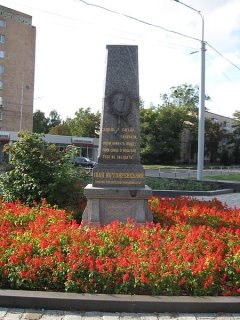 Because it’s welcomed
Because it’s welcomed
Him for ever)
THE MONUMENT AT THE GRAVE
I. P. Kotliarevsky died on November 10, 1838, buried in the park called now after his name. The first tombstone was set in 1839. In 1900 a new tomb has been placed at the grave. Tetrahedral granite obelisk of dark gray color with a bronze bas-relief of the writer in a laurel wreath. Below, there are the words of Taras Shevchenko:
Your reign will last as long, my aire,
As people are alive.
As long as sun shines from above
In memories you’ll thrive!
THE MONUMENT AT THE GRAVE OF KOROLENKO
![]()

A well-known a fiction writer and publicist V. G. Korolenko was buried in December 1921 on a cemetery in Poltava. In 1936 his aches were transferred to the park close to manor in which Korolenko had lived long years.
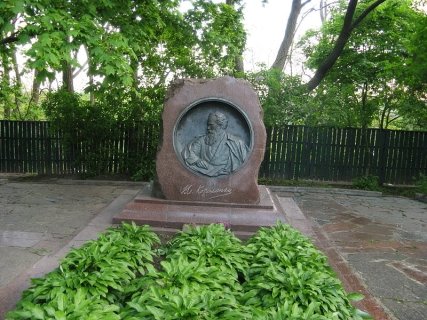 In 1940 his wife was buried next to him. In the same year, work on installation of the monument designed by a female sculptor L. A. Blokh, native of Kremenchuk, was started at the writer's grave.
In 1940 his wife was buried next to him. In the same year, work on installation of the monument designed by a female sculptor L. A. Blokh, native of Kremenchuk, was started at the writer's grave.
During The Great Patriotic War the components of the uncompleted memorial were robbed. In the postwar years, several versions of the monument have been developed by another native of Kremenchuk, sculptor Ya. S. Razhba.
In 1962, a 2 m 15 cm high granite monolith tombstone brought from Zhytomyr region – the native land of the writer, has been set at the grave. It’s made of a red granite slab; its front flat surface contains a bas-relief portrait of the writer within the bronze oval. Below the bronze bas-relief, Korolenko’s autograph has been inscribed. The authors of the monument are sculptor N. V. Krandiyevska, architects V. A. Pasichny and L. S. Weinhort.
The grave of Korolenko and his wife belongs to the Korolenko Literary Memorial Museum complex.
V.G. KOROLENKO’S LITERARY-MEMORIAL MUSEUM
![]()

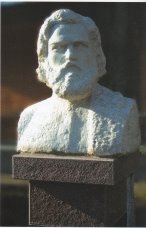 There is a cozy house on a high hill near the Victory city park. The well-known Russian and Ukrainian short story writer, journalist, human rights activist and humanitarian Volodymyr Galaktionovych Korolenko lived and worked in it from summer 1903 to December 25th, 1921. On occasion of the 75th anniversary of his birth, an exhibition “Life and Work of Korolenko” was arranged. Based on it, a literary memorial museum was established in 1940. The memorial part of the exposition was placed in the house where V. Korolenko lived for the last 18 years.
There is a cozy house on a high hill near the Victory city park. The well-known Russian and Ukrainian short story writer, journalist, human rights activist and humanitarian Volodymyr Galaktionovych Korolenko lived and worked in it from summer 1903 to December 25th, 1921. On occasion of the 75th anniversary of his birth, an exhibition “Life and Work of Korolenko” was arranged. Based on it, a literary memorial museum was established in 1940. The memorial part of the exposition was placed in the house where V. Korolenko lived for the last 18 years.
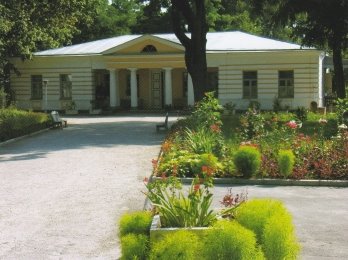 The first director of the museum was its founder, the writer’s daughter Sofia Volodymyrivna. During WWII the exhibits had been evacuated to Sverdlovsk where the museum kept working. Nazis destroyed the house of the writer before their retreat from Poltava. However, the building was restored by December 25, 1946 and the museum resumed operating.
The first director of the museum was its founder, the writer’s daughter Sofia Volodymyrivna. During WWII the exhibits had been evacuated to Sverdlovsk where the museum kept working. Nazis destroyed the house of the writer before their retreat from Poltava. However, the building was restored by December 25, 1946 and the museum resumed operating.
There is a garden outside the museum and a wing that the exhibition hall operates in.
The museum has more than 10 thousand exhibits. It contains unique photographs, autographs of Korolenko, Anton Chekhov, N. G. Chernyshevsky, I. E. Repin and others; his own belongings, books and newspapers from his personal collection etc. In particular, there are portraits of V. Korolenko made by the painter Ivan Parkhomenko (1909) in the museum.
Here is a study of the writer. This is where his heart stopped beating at about 10.30 a.m. A double drawer desk purchased for Korolenko’s first literary fees that he used of for 36 years, a glass inkstand, 2 Karelian birch pens, a wooden couch made according to the draft by Korolenko - everything here reminds of the selfless, devoted worker, talented man, whom the fates of the people among whom he lived were near and dear to... He wrote “History of My Contemporary”, “Sorochintsi Tragedy” and other works there.
In this building that the memorial plaque is now established on fasade Volodymyr Korolenko met many famous workers of culture. People went to his place for advice, to share their grief and entrust themselves to him with their inmost thoughts. He was loved and trusted. He was concerned about needs of ordinary people, their troubles. He defended the interests of the working people.
Over the difficult years of the Bolshevik despotism and mass repression, Korolenko advocated for domestic cultural workers, for human rights and against injustices and persecutions on the social class basis, publicly condemned the means of building the socialism in the Soviet Union, proclaimed outcry against the new epoch’s “largest becoming brutal” and against the executions, criticized both Red Terror and White Terror. He also assisted to establish orphanages, did much for starving children during the famine years.
Poltava National Pedagogical University, the city comprehensive school No 10 and one of the streets has been named after the democrat writer.
THE ROTUNDA “FRIENDSHIP OF THE PEOPLE”
![]()

The beautiful legend says that this place where there were two bastions was visited by Peter the Great after the battle. His horse lost a horseshoe, but the local smith quickly changed it, having received in gratitude a generous gift from the tsar. The White Rotunda with wooden columns was established in one of the memorable places of protection of Poltava
The White Rotunda was opened just before the celebration a bicentenial of the battle of Poltava on June 27th 1909. This monument was erected on the spot of Podolsky watchtower and bastion of the former fortress of Poltava. The fortress was not protected by stonewalls but only 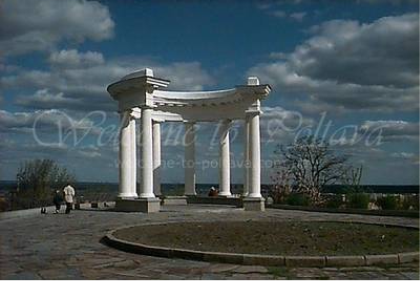 by earthworks, palisades and the steep slopes of the hill where it was built.
by earthworks, palisades and the steep slopes of the hill where it was built.
During the German occupation of Poltava in 1941-1943 the White Rotunda was destroyed because an artillery observation post was located on its site. In 1954 the Rotunda of Peoples Friendship designed by architect Vaingort was opened here to mark three-hundredth anniversary of Pereyaslav Treaty signed between Russia and Ukraine. In 2004 the monument was reconstructed and the following line, written by famous Ukrainian writer Ivan Kotliarevsky was cut into the top of the arbor: ”Only there each and all live in peace, quit and chime could be a blessed land and a happy people.”
Near the White Rotunda there is an observation area that attracts many tourists with marvelous view of the suburbs, the Vorskla river and Holy Cross Exaltation Monastery. In 1974 a memorial stone was opened here in commemoration of the first mention of the city of Poltava in Ipatievskaya chronicle that dates back to 1174.
 THE GLORY MONUMENT AND THE CORPS GARGEN
THE GLORY MONUMENT AND THE CORPS GARGEN
![]()
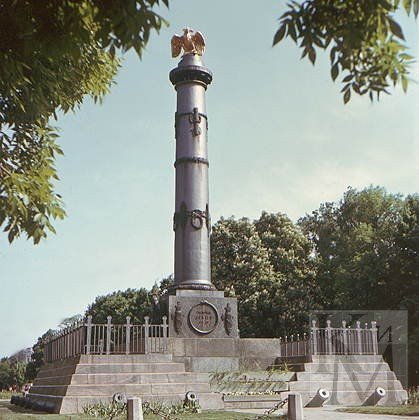 This monument is a primary sight of central Poltava where eight streets converge radially. The majestic Glory Monument was set up in honour of the 100th anniversary of Poltava Battle. It was unveiled on the exact site where a meeting between the Russian Army headed by Tsar Peter I and Poltava fortress’ garrison headed by Colonel Kelin took place soon after the Battle of Poltava. On the eve of the meeting a large triumphal arch was built there. The monument was designed by a local architect M. Amvrosimov and some changes were put to the rough sketch by famous Russian architect (of French origin) Thomas de Thomon.
This monument is a primary sight of central Poltava where eight streets converge radially. The majestic Glory Monument was set up in honour of the 100th anniversary of Poltava Battle. It was unveiled on the exact site where a meeting between the Russian Army headed by Tsar Peter I and Poltava fortress’ garrison headed by Colonel Kelin took place soon after the Battle of Poltava. On the eve of the meeting a large triumphal arch was built there. The monument was designed by a local architect M. Amvrosimov and some changes were put to the rough sketch by famous Russian architect (of French origin) Thomas de Thomon.
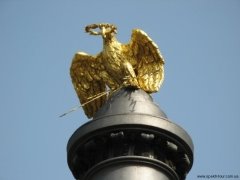 About 135,000 roubles were collected throughout the country for this project. Governor-General Count Alexey Kurakin laid a foundation stone on June 27th 1804. The square granite pedestal of the monument has a shape of the fortress and is fenced in with many cast-iron ground-directed swords symbolize peace. Eighteen guns that were in use during the battle were mounted into its foundation. The monument’s high cast-iron column was manufactured in Lugansk (Eastern Ukraine) and crowned with gilded bronze eagle holding arrows in his claws and fastening his eyes towards the battlefield. The height of the monument is nearly 17 metres. It looks like a fortress.
About 135,000 roubles were collected throughout the country for this project. Governor-General Count Alexey Kurakin laid a foundation stone on June 27th 1804. The square granite pedestal of the monument has a shape of the fortress and is fenced in with many cast-iron ground-directed swords symbolize peace. Eighteen guns that were in use during the battle were mounted into its foundation. The monument’s high cast-iron column was manufactured in Lugansk (Eastern Ukraine) and crowned with gilded bronze eagle holding arrows in his claws and fastening his eyes towards the battlefield. The height of the monument is nearly 17 metres. It looks like a fortress.
An official opening ceremony took place on June 27th 1811.
In 1802 Poltava was named as an administrative center of a newly established government. All buildings around the central square were designed in a classic style by famous Russian architect A. Zakharov and completed during the first decade of XVIII century. In 1840 a military school named after Peter I was opened close to the monument. A square around the monument was used as a drill square until 1852.
During the fascists occupation the monument was ruined. On September 23, 1943 the red flag of victory was raised on the monument. The monument was restored in 1950 and then in 1960s.
.There is a garden around the monument. Geometrically the Corps garden represents an ideal circle in diameter of 345 metres. The first plantings around the Glory monument appeared in the fortieth years of the 19th century. Originally the garden was under the authority of the
![]() THE MONUMENT OF GLORY
THE MONUMENT OF GLORY

 The Monument of Glory is the main place of interest of the Poltava central part. It was erected at the place where Peter the Great had a meeting with the garrison of the fortress and the local citizens on June, 27, 1709. The Triumphal arch was built at this place the day before the meeting. The idea of the monument creation belonged to the province architect V. Amvrosimov. Some changes in the project were done by the famous architect of the French origin – Tomah de Tomon (1759 – 1813). The sum of 135000 rubles was gathered for the monument erection; the tsar Alexandr I gave the money for the molding of the Eagle and bronze adornments. The square pedestal of the monument was created in the form of the fortress and the cast-iron fence was made in the form of swords, which edges were fixed in the ground. The cast-iron column was made at the Lugansk cast-iron plant, and the bronze details of the pedestal were made in Saint-Petersburg. 18 cannons were set into the base of the monument; these cannons were used in the fortress bastions of Poltava and Perevolochnaya. The light grey granite for the monument was extracted at the quarry near Kremenchug. The monument is decorated by the gilded eagle that keeps the arrows of the war pointed to The Poltava Battle Field in its claws and the laurel wreath in its beak. The monument was opened on June, 27, 1811; however it was planned to be opened to the 100 anniversary of the Battle in 1809. The foundation of the park around the monument was laid in 1852; this park is a sample of landscape art. The ring road appeared later on and the park itself was surrounded by the beautiful cast-iron fence. The complex of the administrative buildings was built around the square at the beginning of the XIX century. It was created by the project of the famous Russian architect A. Zakharov in a pure Classic style.
The Monument of Glory is the main place of interest of the Poltava central part. It was erected at the place where Peter the Great had a meeting with the garrison of the fortress and the local citizens on June, 27, 1709. The Triumphal arch was built at this place the day before the meeting. The idea of the monument creation belonged to the province architect V. Amvrosimov. Some changes in the project were done by the famous architect of the French origin – Tomah de Tomon (1759 – 1813). The sum of 135000 rubles was gathered for the monument erection; the tsar Alexandr I gave the money for the molding of the Eagle and bronze adornments. The square pedestal of the monument was created in the form of the fortress and the cast-iron fence was made in the form of swords, which edges were fixed in the ground. The cast-iron column was made at the Lugansk cast-iron plant, and the bronze details of the pedestal were made in Saint-Petersburg. 18 cannons were set into the base of the monument; these cannons were used in the fortress bastions of Poltava and Perevolochnaya. The light grey granite for the monument was extracted at the quarry near Kremenchug. The monument is decorated by the gilded eagle that keeps the arrows of the war pointed to The Poltava Battle Field in its claws and the laurel wreath in its beak. The monument was opened on June, 27, 1811; however it was planned to be opened to the 100 anniversary of the Battle in 1809. The foundation of the park around the monument was laid in 1852; this park is a sample of landscape art. The ring road appeared later on and the park itself was surrounded by the beautiful cast-iron fence. The complex of the administrative buildings was built around the square at the beginning of the XIX century. It was created by the project of the famous Russian architect A. Zakharov in a pure Classic style.

![]() THE MONUMENT TO MARUSIA CHURAI
THE MONUMENT TO MARUSIA CHURAI
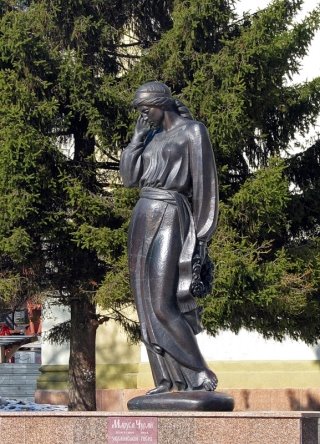 This symbolic monument dedicated to the immortal Ukrainian folk songs represented by the legendary figure of talented Poltava female singer and song writer Marusia Churai living under hetman Bohdan Khmelnytsky is located in the downtown at Theatre Square near the fountain in front of the Regional Academic Musical Drama Theatre named after Gogol. The work is made by Anatoly Chernoshchokov, a well-known Poltava man of art, People’s Artist of Ukraine, and Andriy Koryshev, sculptor, and initiated by Anatoly Kukoba, the then mayor of Poltava. The monument was created for 3 months by initially making a clay figure of a girl that was afterwards made of concrete. It was unveiled on April 14, 2006.
This symbolic monument dedicated to the immortal Ukrainian folk songs represented by the legendary figure of talented Poltava female singer and song writer Marusia Churai living under hetman Bohdan Khmelnytsky is located in the downtown at Theatre Square near the fountain in front of the Regional Academic Musical Drama Theatre named after Gogol. The work is made by Anatoly Chernoshchokov, a well-known Poltava man of art, People’s Artist of Ukraine, and Andriy Koryshev, sculptor, and initiated by Anatoly Kukoba, the then mayor of Poltava. The monument was created for 3 months by initially making a clay figure of a girl that was afterwards made of concrete. It was unveiled on April 14, 2006.
As basis of the monument were taken legends about Poltava girl Marusia who lived in the 17th century and had extraordinarily fine voice and aptitude for writing lyrics. It is her creative work that a number of Ukrainian folk songs is referred to, the most famous songs of which are “Ой, не ходи Грицю, та й на вечорниці” (Hryts, Don't Go to the Evening Dancing), “Засвіт встали козаченьки” (The Cossacks Were Ready to March at Dawn) etc. There is popular belief that Marusia poisoned the Poltava Cossack Regiment cornet Hryts (Ukrainian for Gregory) whom she had loved and been loved by, as he betrayed their love and got married to the rich one. Therefore the proud female Poltavite was charged with poisoning her beloved Hryts, was found guilty and was executed. Another folk belief tells the betrayed girl could endure her loss, so she secretly sought assistance from some local old witch to prepare a deadly potion for herself but Hryts drank it up by accident before she could get to it. She was accused of murder, and stood trial. The exact verdict was unknown, but she is believed to have spent some time in incarceration, before being released or amnestied, commonly believed due to her reputation as a well-known songster. According to one more legend, in summer 1652 Poltava court sentenced Marusia to death, but she was amnestied by a universal of the hetman Bohdan Khmelnytsky that a Cossack Iskra brought. It read to give her life “for her father's achievements and sweet songs”. To seek repentance, the girl walked the pilgrimage to Kyiv but returned 1653 to Poltava and died at the age of 28, because she could not bear to live without her beloved. (According to other sources, she died of consumption in Poltava 1652 shortly after the amnesty or became a nun at any of Ukrainian nunneries).
The Monument to Marusia Churai (to Ukrainian Song) represents a figure of a young girl in the Ukrainian traditional garment, who bows her head while feeling slightly sad and holding a bundle of herbs for potion in her left hand and raising the right one up to her face.
The monument cast in concrete is 3.5 meters high; its upper part is covered with copper.
According to the numerous polls, the Marusia monument is one of the most popular new monuments with Poltava people.

![]() THE MONUMENT TO SHEVCHENKO
THE MONUMENT TO SHEVCHENKO
In 1921 the governmental department of education announced the competition for choosing the best project of the monument to the son of the Ukrainian people T. Shevchenko.
Sculptor I. Kavaleridze took part in the competition. His project differed in the innovation decision and was accepted as the best one.
In March 1926, a monument of Taras Shevchenko (1814 - 1861) has been unveiled in the  Petrovsky Park. It is one of few monuments in Ukraine made in style of cubism. Sculptor I. P. Kavaleridze has solved its design untraditionally: it seems a powerful figure of the fighter poet grows up from gray asymmetric blocks. As well as many other his works this monument is made of reinforced concrete –a new material for that time.
Petrovsky Park. It is one of few monuments in Ukraine made in style of cubism. Sculptor I. P. Kavaleridze has solved its design untraditionally: it seems a powerful figure of the fighter poet grows up from gray asymmetric blocks. As well as many other his works this monument is made of reinforced concrete –a new material for that time.
Out of the huge stones merges the magnificent figure of the poet. The height is 5 metres.
The pyramidal pedestal bears the inscription “ T. H. Shevchenko”
Thousands of Poltava inhabitants and those of the surrounding villages gathered on occasion of the celebration due to the unveiling the Shevchenko monument. The choir of many thousands performed Shevchenko’s "Testament." Two lines from that immortal artifact are imprinted on the pedestal:
…And water with the tyrants' blood
The freedom you have gained.
During the war some its details suffered but fortunately it was possible to restore the monument.
The great poet has been to Poltava, to other towns and villages in Poltava region once and again. In this land, he wrote the narrative poems "The Heretic" and "the Blind Man", a poem "Do Not Envy a Rich Man" and other works. Staying in Poltava in 1845 he visited the farmstead of Kotliarevsky on Ivan's Hill, drew the house, took an interest in the other places related to the life and work of the author of “Eneida”, “Natalka Poltavka”, “Magician Moskal”.
KOTLIAREVSKYI MEMORIAL COMPLEX
![]()

Restored in 1969 according to the project of the architect V. Tertyshnyi and constructor A. Malinovskyi.
Memorial complex consists of the house, awning, warehouse and well.
There are 5 small rooms in the house: cabinet, sitting-room, bedroom, kitchen. There is an authentic ceiling beam in the house that has remained since the times of the writer’s life.
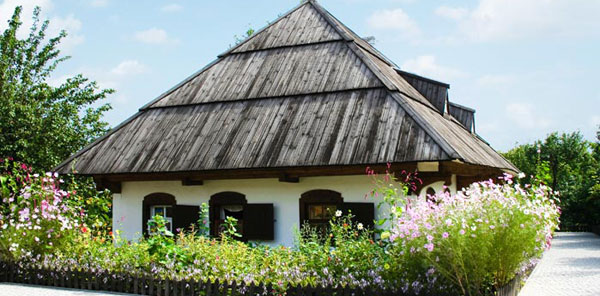 The interior of the house, where writer’s memorial things, awards, hand-written pages of the great works as well as furniture, items of nobility’s use of the beginning of the19th century are preserved, is restored to the maximum of the recollections of the contemporaries of I. Kotliarevskyi.
The interior of the house, where writer’s memorial things, awards, hand-written pages of the great works as well as furniture, items of nobility’s use of the beginning of the19th century are preserved, is restored to the maximum of the recollections of the contemporaries of I. Kotliarevskyi.
In this country estate I. Kotliarevkyi died away on the 10th of November, 1838.
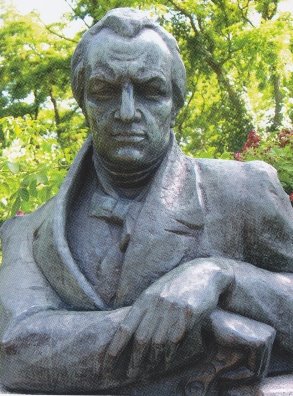
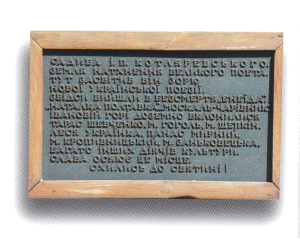
ART GALLERY
![]()

Gallery of Arts in Poltava is known as one of the most important galleries in Ukraine. A large exhibition room, the area of which is 550 square meters, is suitable for carrying out of large-scale exhibitions. And its technical facilities, transforming pylons, general and directed light make it possible to take any expositional decision.
Gallery press-center, the total roominess of which is 70 seats, can be easily transformed into literary-music reception room, that makes possible to conduct here not only different meetings and conferences, but also exhibitions presentations, chamber concerts, literary-music evenings.
The atmosphere of the bright holiday, that occurs when meeting beautiful things, is wholly supported by ‘winter garden’. Here tropic plants and aquarium with exotic fish are harmonically neighboring with sculptures.
The main type of gallery activities is exhibition activities. The exposition of the large exhibition room is changed every month. The duration of every exhibition averages three weeks.
 During the time of Poltava Gallery of Arts existence it has been formed some typical traditions. For instance, on the Christmas Eve, it is ‘Christmas meetings’ exhibition that usually take place, during which you can get acquainted with new works of contemporary artists, which are enrolled to the National Union of Artist of Ukraine.
During the time of Poltava Gallery of Arts existence it has been formed some typical traditions. For instance, on the Christmas Eve, it is ‘Christmas meetings’ exhibition that usually take place, during which you can get acquainted with new works of contemporary artists, which are enrolled to the National Union of Artist of Ukraine.
All Fools’ Day, the 1st of April, Poltava citizens usually connect with international exhibition – the caricature contest.
Easter exhibitions are also very popular. A wonderful room acoustics makes it possible to transform it into concert room, where you can often hear the symphonic music and opera voices.
THE LOCAL LORE MUSEUM
![]()

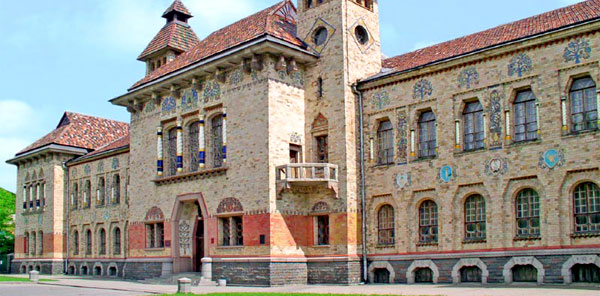
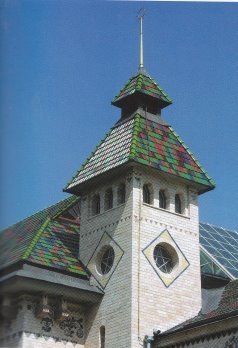 The building of the province local government was built in 1903 – 1908 by the V. Krichevsky project, using the projects of E. Shirshov and M. Nikolaev. This building became the sample of Ukrainian style of architecture. This building is decorated by the city emblems of the province that gives it some solemnity. Two high towers with the small loopholes remind us Poltava fortress of XII – XIII centuries. The Local Lore Museum was established in this building on the initiative of the soil scientist, Professor V. Dokuchaev.
The building of the province local government was built in 1903 – 1908 by the V. Krichevsky project, using the projects of E. Shirshov and M. Nikolaev. This building became the sample of Ukrainian style of architecture. This building is decorated by the city emblems of the province that gives it some solemnity. Two high towers with the small loopholes remind us Poltava fortress of XII – XIII centuries. The Local Lore Museum was established in this building on the initiative of the soil scientist, Professor V. Dokuchaev.
The museum was robbed and burnt during the German invasion in 1943. The private offices of Gogol, Kotliarevsky, Myrny, Teslenko, documents and relics of the Poltava Battle were destroyed. Only 37000 exhibits out of 118000 left after the war. The contemporary exhibition consists of the departments of religion and folklore. Our museum is one of the oldest and biggest museums of Ukraine.
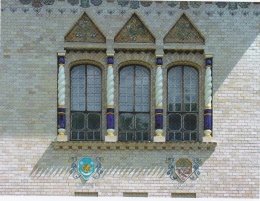
![]()

про публікацію авторської розробки
Додати розробку
